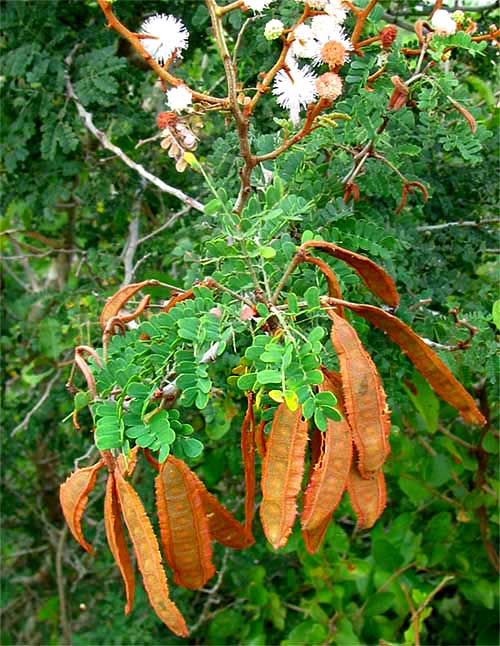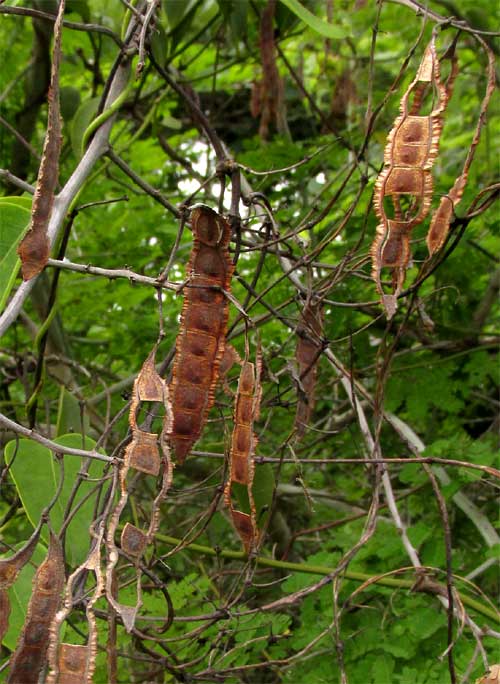Excerpts from Jim Conrad's
Naturalist Newsletter
from the August 25, 2008 Newsletter written in Sabacché and issued from a ciber in nearby Tekit, Yucatán, MÉXICO
MIMOSAS FLOWERING & FRUITING
The scrub surrounding Sabacché, as it was at my former locations in the Yucatan, is dominated by woody, frilly-leafed, often spiny members of the Bean Family. By "frilly-leafed I mean that the leaf blades are once- or twice-pinnately compound -- compound leaves composed of numerous smaller leaflets. You can meet some of the most common Yucatan members of this group at http:www.backyardnature.net/yucatan/yuc-herb.htm#e.
Now in the heart of the rainy season our most conspicuously flowering of the group is MIMOSA BAHAMENSIS. Local people call it Catzin, but when I remind them that that's what they also call a common acacia with enormous, thick-based spines -- one of the Bull-horn Acacias -- they admit it's true, and add that it also can be called Sak-Catzin. "Sak" means white, and probably refers to the abundant white flower heads.
Sak-Catzin is a small tree very common along roadsides and recently abandoned fields. In other words, despite being woody, it's almost weedy. It seldom grows more than 15 feet tall. You can see its flowers and fruits below:

Though several members of the group produce fuzzy-looking, spherical flower-heads, this species' flat legumes are fairly distinctive with their brownish, papery, jagged wings along both sides of the flat pods' faces.
The local folks more or less ignore this plant, it being too small to produce firewood, and not known as being particularly medicinal, though some say somewhat vaguely that it has been used for baby medicine. Its abundant flowers do feed untold numbers of nectar- and pollen-seeking invertebrates, which in turn feed birds, which perform many services in the scrub, so Mimosa bahamensis is a good citizen nonetheless.
from the July 20, 2018 Newsletter issued from Rancho Regenesis in the woods ±4kms west of Ek Balam Ruins; elevation ~40m (~130 ft), N~20.876°, W~88.170°, central Yucatán, MÉXICO
THE BAHAMA MIMOSA'S CURIOUS LEGUMES
During my recent camping trip to southwestern Campeche state, on the morning of July 2nd I emerged from the woods near the entrance to Chicanná ruins and began hiking eastward on the main highway between Chetumal and Escárcega. Soon it became apparent that vegetation in that area consisted mostly of species we also have in the northern Yucatan, just that the mix is different.
For example, around Ek Balam in the north the Wild Tamarind, Leucaena leucocephala, for long distances often forms nearly pure stands along roadsides. In southern Campeche, Wild Tamarind also was common along roads, but it's seldom much dominant over other species. Weedy roadsides were more diversified, probably because of the greater rainfall than up north.
A weedy shrub or small tree sharing the roadsides with Wild Tamarind was the Bahama Mimosa, often called Catsin by the Maya. Above, we see that the tree's legume-type fruits are unusual, being flattish, with papery, jagged "wings" along their margins. Near Chicanná ruins I saw the species' mature fruits doing something interesting, shown below:

Notice that instead of whole legumes falling from the tree, individual legume sections, called joints, come loose and fall away. Typically legumes split lengthwise, releasing bean-type seeds, but here the legume splits from side to side, and the seeds fall away still encased in squarish sections of legume husk. I've always assumed that the legumes' wings caught in the wind, helping the wind blow the legumes off the tree, but now I'm supposing that the wings cause the legumes to shake the squarish segments loose from their pods, to be blown away individually.
Because Bahama Mimosa is so weedy, I've always assumed that it enjoyed a wide distribution, but now I see that it's limited to the Bahamas and the Yucatan Peninsula, including Belize and lowland northern Guatemala.
One wonders why Bahama Mimosa doesn't also occur in the sizable landmass of Cuba, which lies exactly between the Bahamas and the Yucatan Peninsula. Some have suggested that ocean currents could have transported the seeds, but Grether and Camargo-Ricalde in their 1993 work "Mimosa bahamensis (Leguminosae) en la Península de Yucatán, México," (Boletín de la Sociedad Botánica de México 53) found that the tree's mature legumes as well as individual joints sink in water after 24 to 72 hours.
Hurricanes probably wouldn't have blown fruits and joints that far, and if they did, it's hard to see how they could have avoided sowing seeds in Cuba, where soil conditions are good for them. We're left with the idea that humans may have introduced the species from the Yucatan into the Bahamas, either intentionally or not. It's known that the prehispanic Maya traveled long distances in their canoes. But, if the Maya took seeds to the Bahamas, why not Cuba?
It's just one of those mysteries we may never solve.